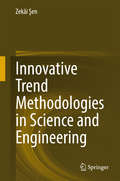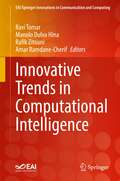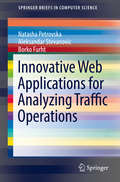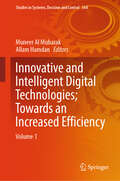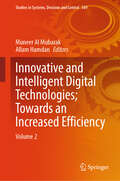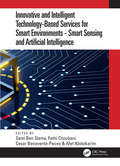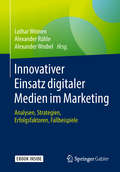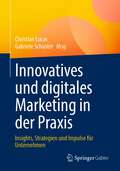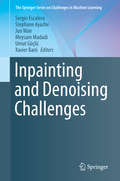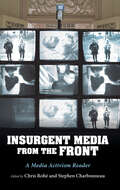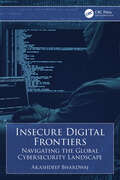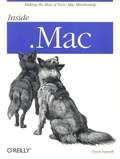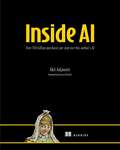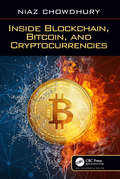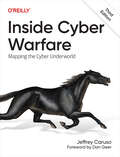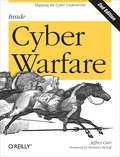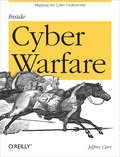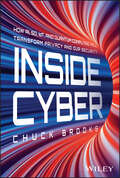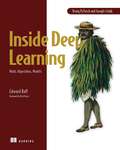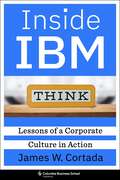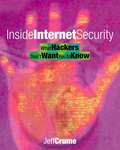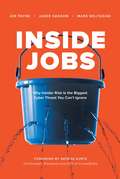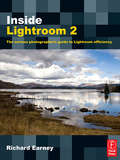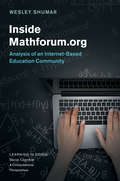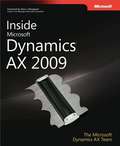- Table View
- List View
Innovative Trend Methodologies in Science and Engineering
by Zekâi ŞenThis book covers all types of literature on existing trend analysis approaches, but more than 60% of the methodologies are developed here and some of them are reflected to scientific literature and others are also innovative versions, modifications or improvements. The suggested methodologies help to design, develop, manage and deliver scientific applications and training to meet the needs of interested staff in companies, industries and universities including students.Technical content and expertise are also provided from different theoretical and especially active roles in the design, development and delivery of science in particular and economics and business in general. It is also ensured that, wherever possible and technically appropriate, priority is given to the inclusion and integration of real life data, examples and processes within the book content.The time seems right, because available books just focus on special sectors (fashion, social, business). This book reviews all the available trend approaches in the present literature on rational and logical bases.
Innovative Trends in Computational Intelligence (EAI/Springer Innovations in Communication and Computing)
by Rafik Zitouni Ravi Tomar Manolo Dulva Hina Amar Ramdane-CherifThis book addresses the key problems that computational intelligence aims to solve, including (i) the involved computational process might be too complex for mathematical reasoning; (ii) it might contain some uncertainties during the process, or (iii) by nature, the computational process is a randomly determined one (heuristic). The contributors make use of methods that are close to the human's way of reasoning, that is, available information might be inexact or incomplete, yet it would be able to produce controlled actions in an adaptive way. Approaches presented in the book include swarm intelligence, artificial immune systems, image processing, data mining, natural language processing, text mining, and other solutions involving artificial intelligence methodologies.
Innovative Web Applications for Analyzing Traffic Operations
by Borko Furht Natasha Petrovska Aleksandar StevanovicIn response to the need to improve road traffic operation, researchers implement advanced technologies and integration of systems and data, and develop state-of-the-art applications to assist traffic engineers. This SpringerBrief introduces three novel Web applications which can be an exceptional resource and a good visualization tool for traffic operators, managers, and analysts to monitor the congestion, and analyze incidents and signal performance measures. The applications offer more detailed analysis providing users with insights from different levels and perspectives. The benefit of providing these automated and interactive visualization tools is more efficient estimation of the local transport networks' performance, thus facilitating the decision making process in case of emergency events.
Innovative and Intelligent Digital Technologies; Towards an Increased Efficiency: Volume 1 (Studies in Systems, Decision and Control #564)
by Allam Hamdan Muneer Al Mubarak"Innovative and Intelligent Digital Technologies: Towards Increased Efficiency" is a groundbreaking book that explores the transformative power of cutting-edge digital solutions. From artificial intelligence to blockchain, this comprehensive guide reveals how these technologies can reshape businesses, streamline processes, and drive unprecedented growth. Packed with real-world case studies and expert analysis, this book equips you with the knowledge and strategies to stay ahead in today's rapidly evolving digital landscape. Discover the secrets to increased efficiency, improved productivity, and sustainable growth by embracing the future of technology.
Innovative and Intelligent Digital Technologies; Towards an Increased Efficiency: Volume 2 (Studies in Systems, Decision and Control #569)
by Allam Hamdan Muneer Al MubarakThis book delves into how these technologies, including artificial intelligence, machine learning, data analytics, and the Internet of Things, are revolutionizing business operations. Through real-world case studies and expert analysis, the book showcases practical applications of these technologies in sectors like manufacturing, health care, finance, and logistics. It highlights the benefits and challenges of adopting these innovations, offering valuable insights for organizations seeking improved efficiency. The book also addresses ethical considerations and societal implications, including data privacy, security, and the future of work in an increasingly digitized world. It emphasizes the responsible implementation of digital technologies for a sustainable and inclusive future.
Innovative and Intelligent Technology-Based Services For Smart Environments - Smart Sensing and Artificial Intelligence: Proceedings of the 2nd International Conference on Smart Innovation, Ergonomics and Applied Human Factors (SEAHF’20), held online, 14-15 November 2020
by Sami Ben SlamaThis book contains a collection of high-quality papers describing the results of relevant investigations and cutting-edge technologies, aimed at improving key aspects of real life, including major challenges such as the development of smart cities, smart buildings, smart grids, and the reduction of the impact of human activities on the environment. Sustainability requires the use of green technologies and techniques and good practices. Artificial intelligence seems to be an appropriate approach to optimize the use of resources. The main focus of this book is the dissemination of novel and innovative technologies, techniques and applications of artificial intelligence, computing and information and communications technologies, and new digital services such as digital marketing, smart tourism, smart agriculture, green and renewable energy sources. Besides, this book focuses on nurturing energy trends including renewable energies, smart grids, human activity impact, communication, behaviour, and social development, and quality of life improvement fields based on the innovative use of sensors, big data and the Internet of things (IoT), telecommunications and machine learning.
Innovativer Einsatz digitaler Medien im Marketing: Analysen, Strategien, Erfolgsfaktoren, Fallbeispiele
by Lothar Winnen Alexander Rühle Alexander WrobelDieses Buch zeigt fundiert, wie digitale Medien für unterschiedliche Zielsetzungen im Marketing passgenau eingesetzt werden können. Digitalexperten aus Wissenschaft und Praxis geben wertvolle Einblicke in die aktuellen Nutzungsmöglichkeiten. Neben neuesten Forschungsergebnissen zu den Themen Dynamic Pricing, Einsatz von Bots, Transmediales Marketing, Recruiting oder Mobile Marketing liefern sie wichtige Erkenntnisse und konkrete Praxisbeispiele aus unterschiedlichen Branchen.Ein inspirierendes Werk, das kluge Wege aufzeigt, um Ziele und Zielgruppen auch in einer zunehmend dynamischen Welt erfolgreich und nachhaltig zu erreichen.
Innovatives und digitales Marketing in der Praxis: Insights, Strategien und Impulse für Unternehmen
by Christian Lucas Gabriele SchusterDieses Buch liefert einen Überblick über neue Einsatzmöglichkeiten und Wirkmechanismen von digitalem Marketing. Es gibt vielfältige Impulse und zeigt anhand eines breiten Themenportfolios, welche Strategien sich für die praktische Anwendung in der Wirtschaft eignen. Die Autor:innen, allesamt Hochschuldozierende und praxiserfahrene Marketingexpert:innen, betrachten dabei die Auswirkungen der kontinuierlichen Vernetzung und Digitalisierung im gesamten Marketingprozess – und geben Antworten auf folgende Fragen: Welche Auswirkungen hat die Digitalisierung auf die Kund:innen? Wie emotionalisiert man Kundenbeziehungen und wie sieht eine erfolgreiche Customer Journey aus? Welche Potenziale haben Open Innovation, Growth Hacking, Blockchain und Künstliche Intelligenz im Marketing? Was gilt es bei E-Commerce-Strategien und beim Dynamic Pricing zu beachten? Was ist eine Corporate Digital Responsibility und welche Bedeutung haben Corporate Podcasts? Was müssen Unternehmen in besonderen Segmenten wie im B2B oder auch bei der Zielgruppe 50+ heute beachten? Ein leicht verständliches und praxisnahes Werk, das Marketingverantwortliche in Unternehmen in die Lage versetzt, gezielt dort nachzusteuern, wo sie gerade akuten Bedarf haben. Mit Beiträgen von:Elisa Dorothee Adam Christoph Albers Prof. Dr. Josef Arweck Prof. Dr. Thomas Bolz Prof. Dr. Georg Bouché Simon Ens Dr. Eva Ghazari-ArndtProf. Dr. Maik Günther Prof. Dr. Nele Hansen Dr. Natascha Hebestreit Prof. Dr. Claudia Hess Prof. Dr. Dr. Dietmar Janetzko Prof. Dr. Marion Kalteis Prof. Dr. Jan Thido Karlshaus Prof. Dr. Anna Klein Prof. Dr. Ralf Kneuper Prof. Dr. Cordula KreuzenbeckProf. Dr. Alexandra Kühte Prof. Dr. Sibylle Kunz Prof. Dr. Rico ManßProf. Dr. Michaela Moser Prof. Dr. Susanne O’Gorman Prof. Dr. Jochen Panzer Prof. Dr. Sven Pastowski Prof. Dr. Jan Pieper Prof. Dr. Jonas Polfuß Prof. Dr. Katharina-Maria Rehfeld Prof. Dr. Verena Renneberg Prof. Dr. Angela Rohde Prof. Dr. Uta Scheunert Prof. Dr. Daniel Schmid Prof. Dr. Benjamin Krischan Schulte Prof. Dr. Carsten Skerra Prof. Dr. Felix Wölfle Prof. Dr. Lisa-Charlotte Wolter Prof. Dr. Matthias Zeisberg Prof. Dr. Ina zur Oven-Krockhaus Prof. Dr. Tanja Zweigle
Inpainting and Denoising Challenges (The Springer Series on Challenges in Machine Learning)
by Xavier Baró Sergio Escalera Umut Güçlü Stephane Ayache Jun Wan Meysam MadadiThe problem of dealing with missing or incomplete data in machine learning and computer vision arises in many applications. Recent strategies make use of generative models to impute missing or corrupted data. Advances in computer vision using deep generative models have found applications in image/video processing, such as denoising, restoration, super-resolution, or inpainting. Inpainting and Denoising Challenges comprises recent efforts dealing with image and video inpainting tasks. This includes winning solutions to the ChaLearn Looking at People inpainting and denoising challenges: human pose recovery, video de-captioning and fingerprint restoration. This volume starts with a wide review on image denoising, retracing and comparing various methods from the pioneer signal processing methods, to machine learning approaches with sparse and low-rank models, and recent deep learning architectures with autoencoders and variants. The following chapters present results from the Challenge, including three competition tasks at WCCI and ECML 2018. The top best approaches submitted by participants are described, showing interesting contributions and innovating methods. The last two chapters propose novel contributions and highlight new applications that benefit from image/video inpainting.
InsUrgent Media from the Front: A Media Activism Reader
by Chris Robé and Stephen CharbonneauIn the 1940s, it was 16 mm film. In the 1980s, it was handheld video cameras. Today, it is cell phones and social media. Activists have always found ways to use the media du jour for quick and widespread distribution.InsUrgent Media from the Front takes a look at activist media practices in the 21st century and sheds light on what it means to enact change using different media of the past and present. Chris Robé and Stephen Charbonneau's edited collection uses the term "insUrgent media" to highlight the ways grassroots media activists challenged and are challenging hegemonic norms like colonialism, patriarchy, imperialism, classism, and heteronormativity. Additionally, the term is used to convey the sense of urgency that defines media activism. Unlike slower traditional media, activist media has historically sacrificed aesthetics for immediacy. Consequently, this "run and gun" method of capturing content has shaped the way activist media looks throughout history.With chapters focused on indigenous resistance, community media, and the use of media as activism throughout US history, InsUrgent Media from the Front emphasizes the wide reach media activism has had over time. Visibility is not enough when it comes to media activism, and the contributors provide examples of how to refocus the field not only to be an activist but to study activism as well.
Insecure Digital Frontiers: Navigating the Global Cybersecurity Landscape
by Akashdeep BhardwajInsecure Digital Frontiers is an immersive exploration into the tumultuous realm of cybersecurity, where the ever-expanding digital frontiers are both the battleground and the prize. From the shadows of cybercriminal exploits to the sophisticated dance of advanced persistence threats, this book delves into the vulnerabilities that define our interconnected world. With a panoramic lens, the book navigates through the challenges and opportunities that shape the global cybersecurity landscape, offering readers a comprehensive understanding of the insecurities that permeate our digital existence.Insecure Digital Frontiers is not just a book; it is an exploration of the insecurities that define our digital age. It matters because it goes beyond the surface, unraveling the complexities of cyber threats while providing actionable insights for individuals, organizations, and policymakers. In a world where the digital frontier is both a promise and a peril, this book serves as a guide for navigating the insecurities that define our interconnected existence.Embark on this journey through Insecure Digital Frontiers and discover the vulnerabilities that lurk in the shadows, the innovations that promise security, and the collective responsibility we share in securing our digital future.
Inside .Mac
by Chuck ToporekThis handy, quick reference offers a clear overview of the entire .Mac package and many of its not-so-obvious features. You'll learn how to set up and manage your account quickly and without fuss. Each .Mac service is discussed in an objective, no-frills fashion that'll show you how to use--and what to expect from--iDisk, web mail, your personal web site, and everything else that .Mac offers.
Inside AI: Over 150 billion purchases per year use this author's AI
by Akli AdjaouteSeparate the AI facts from the AI fiction, and discover how you can best put these tools to work in your organization.In Inside AI AI professor and entrepreneur Dr. Akli Adjaoute puts AI in perspective, with informed insights from 30 years spent in the field. His book lays out a pragmatic blueprint that every leader can utilize to drive innovation with artificial intelligence. In Inside AI you&’ll learn how to: Gain insight into diverse AI techniques and methodologies Learn from both successful and failed AI applications Identify the capabilities and limitations of AI systems Understand successful and failed uses of AI in business See where human cognition still exceeds AI Bust common myths like AI&’s threat to jobs and civilization Manage AI projects effectively Inside AI takes you on a journey through artificial intelligence, from AI&’s origins in traditional expert systems all the way to deep learning and Large Language Models. There&’s no hype here—you&’ll get the grounded, evidence-based insights that are vital for making strategic decisions and preparing your business for the future. About the technology Artificial Intelligence enthusiasts promise everything from human-like collaboration on everyday tasks to the end of work as we know it. Is AI just a flash in the pan, or can it really transform how you do business? This intriguing book sifts through the hype and separates the truth from the myths, with clear advice on what AI can—and can&’t—achieve. About the book Inside AI provides a clear-headed overview of modern artificial intelligence, including the recent advances of Generative AI and Large Language Models. Its accessible and jargon-free explanations of leading AI techniques showcase how AI delivers tangible advantages to businesses. Both inspiring and practical, this book provides a proven framework for developing successful AI applications. What's inside Insights from successful and failed AI applications A survey of AI techniques and methodologies Bust common AI myths Manage AI projects effectively About the reader For anyone seeking grounded insights into AI&’s capabilities, including business leaders and decision makers. About the author Akli Adjaoute is the founder of multiple AI-related companies. He served as an adjunct professor at the University of San Francisco and as Scientific Committee Chair and Head of the AI department at EPITA. The technical editor on this book was Richard Vaughan. Table of contents 1 The rise of machine intelligence 2 AI mastery: Essential techniques, Part 1 3 AI mastery: Essential techniques, Part 2 4 Smart agent technology 5 Generative AI and large language models 6 Human vs. machine 7 AI doesn&’t turn data into intelligence 8 AI doesn&’t threaten our jobs 9 Technological singularity is absurd 10 Learning from successful and failed applications of AI 11 Next-generation AI A Tracing the roots: From mechanical calculators to digital dreams B Algorithms and programming languages
Inside Blockchain, Bitcoin, and Cryptocurrencies
by Niaz ChowdhuryThis book covers blockchain from the underlying principles to how it enables applications to survive and surf on its shoulder. Having covered the fundamentals of blockchain, the book turns to cryptocurrency. It thoroughly examines Bitcoin before presenting six other major currencies in a rounded discussion. The book then bridges between technology and finance, concentrating on how blockchain-based applications, including cryptocurrencies, have pushed hard against mainstream industries in a bid to cement their positions permanent. It discusses blockchain as underlying banking technology, crypto mining and offering, cryptocurrency as investment instruments, crypto regulations, and markets.
Inside Cyber Warfare: Mapping the Cyber Underworld
by Jeffrey CarusoGet a fascinating and disturbing look into how state and nonstate actors throughout the world use cyber attacks to gain military, political, and economic advantages. In the third edition of this book, cyber warfare researcher Jeffrey Caruso explores the latest advances in cyber espionage and warfare that have emerged on the battlefields of Ukraine and the Middle East, including cyber attacks that result in the physical destruction of the target and the pairing of cognitive with maneuver warfare.Inside Cyber Warfare features an exclusive deep dive into the wartime operations of an offensive cyber unit of Ukraine's Ministry of Defense as it works to defend the nation against Russian forces, particularly since the 2022 invasion:See what happened when a Ukrainian cyber and special operations team worked together to destroy a secret missile laboratoryExplore the legal status of cyber warfare and civilian hackersDiscover how a cyber team with little money and limited resources learned to create fire from the manipulation of code in automated systemsDistinguish reality from fiction regarding AI safety and existential riskLearn new strategies for keeping you and your loved ones safe in an increasingly complex and insecure world
Inside Cyber Warfare: Mapping the Cyber Underworld (Oreilly And Associate Ser.)
by Jeffrey CarrInside Cyber Warfare provides fascinating and disturbing details on how nations, groups, and individuals throughout the world use the Internet as an attack platform to gain military, political, and economic advantages over their adversaries. The second edition goes beyond the headlines of attention-grabbing DDoS attacks and takes a deep look inside recent cyber-conflicts, including the use of Stuxnet. It also includes a Forward by Secretary Michael Chertoff and a guest essay by Melissa Hathaway, among others.
Inside Cyber Warfare: Mapping the Cyber Underworld (Oreilly And Associate Ser.)
by Jeffrey CarrWhat people are saying about Inside Cyber Warfare"The necessary handbook for the 21st century."--Lewis Shepherd, Chief Tech Officer and Senior Fellow, Microsoft Institute for Advanced Technology in Governments"A must-read for policy makers and leaders who need to understand the big-picture landscape of cyber war."--Jim Stogdill, CTO, Mission Services AccentureYou may have heard about "cyber warfare" in the news, but do you really know what it is? This book provides fascinating and disturbing details on how nations, groups, and individuals throughout the world are using the Internet as an attack platform to gain military, political, and economic advantages over their adversaries. You'll learn how sophisticated hackers working on behalf of states or organized crime patiently play a high-stakes game that could target anyone, regardless of affiliation or nationality.Inside Cyber Warfare goes beyond the headlines of attention-grabbing DDoS attacks and takes a deep look inside multiple cyber-conflicts that occurred from 2002 through summer 2009.Learn how cyber attacks are waged in open conflicts, including recent hostilities between Russia and Georgia, and Israel and PalestineDiscover why Twitter, Facebook, LiveJournal, Vkontakte, and other sites on the social web are mined by the intelligence services of many nationsRead about China's commitment to penetrate the networks of its technologically superior adversaries as a matter of national survivalFind out why many attacks originate from servers in the United States, and who's responsibleLearn how hackers are "weaponizing" malware to attack vulnerabilities at the application level
Inside Cyber: How AI, 5G, IoT, and Quantum Computing Will Transform Privacy and Our Security
by Chuck BrooksDiscover how to navigate the intersection of tech, cybersecurity, and commerce In an era where technological innovation evolves at an exponential rate, Inside Cyber: How AI, 5G, and Quantum Computing Will Transform Privacy and Our Security by Chuck Brooks emerges as a critical roadmap for understanding and leveraging the next wave of tech advancements. Brooks, a renowned executive and consultant, breaks down complex technological trends into digestible insights, offering a deep dive into how emerging technologies will shape the future of industry and society. In the book, you'll: Gain clear, accessible explanations of cutting-edge technologies such as AI, blockchain, and quantum computing, and their impact on the business world Learn how to navigate the cybersecurity landscape, safeguarding your business against the vulnerabilities introduced by rapid technological progress Uncover the opportunities that technological advancements present for disrupting traditional industries and creating new value Perfect for entrepreneurs, executives, technology professionals, and anyone interested in the intersection of tech and business, Inside Cyber equips you with the knowledge to lead in the digital age. Embrace the future confidently with this indispensable guide.
Inside Deep Learning: Math, Algorithms, Models
by Edward RaffJourney through the theory and practice of modern deep learning, and apply innovative techniques to solve everyday data problems.In Inside Deep Learning, you will learn how to: Implement deep learning with PyTorch Select the right deep learning components Train and evaluate a deep learning model Fine tune deep learning models to maximize performance Understand deep learning terminology Adapt existing PyTorch code to solve new problems Inside Deep Learning is an accessible guide to implementing deep learning with the PyTorch framework. It demystifies complex deep learning concepts and teaches you to understand the vocabulary of deep learning so you can keep pace in a rapidly evolving field. No detail is skipped—you&’ll dive into math, theory, and practical applications. Everything is clearly explained in plain English. About the technology Deep learning doesn&’t have to be a black box! Knowing how your models and algorithms actually work gives you greater control over your results. And you don&’t have to be a mathematics expert or a senior data scientist to grasp what&’s going on inside a deep learning system. This book gives you the practical insight you need to understand and explain your work with confidence. About the book Inside Deep Learning illuminates the inner workings of deep learning algorithms in a way that even machine learning novices can understand. You&’ll explore deep learning concepts and tools through plain language explanations, annotated code, and dozens of instantly useful PyTorch examples. Each type of neural network is clearly presented without complex math, and every solution in this book can run using readily available GPU hardware! What's inside Select the right deep learning components Train and evaluate a deep learning model Fine tune deep learning models to maximize performance Understand deep learning terminology About the reader For Python programmers with basic machine learning skills. About the author Edward Raff is a Chief Scientist at Booz Allen Hamilton, and the author of the JSAT machine learning library. Table of Contents PART 1 FOUNDATIONAL METHODS 1 The mechanics of learning 2 Fully connected networks 3 Convolutional neural networks 4 Recurrent neural networks 5 Modern training techniques 6 Common design building blocks PART 2 BUILDING ADVANCED NETWORKS 7 Autoencoding and self-supervision 8 Object detection 9 Generative adversarial networks 10 Attention mechanisms 11 Sequence-to-sequence 12 Network design alternatives to RNNs 13 Transfer learning 14 Advanced building blocks
Inside IBM: Lessons of a Corporate Culture in Action
by James W. CortadaIBM was the world’s leading provider of information technologies for much of the twentieth century. What made it so successful for such a long time, and what lessons can this iconic corporation teach present-day enterprises?James W. Cortada—a business historian who worked at IBM for many years—pinpoints the crucial role of IBM’s corporate culture. He provides an inside look at how this culture emerged and evolved over the course of nearly a century, bringing together the perspectives of employees, executives, and customers around the world. Through a series of case studies, Inside IBM explores the practices that built and reinforced organizational culture, including training of managers, employee benefits, company rituals, and the role of humor. It also considers the importance of material culture, such as coffee mugs and lapel pins.Cortada argues that IBM’s corporate culture aligned with its business imperatives for most of its history, allowing it to operate with a variety of stakeholders in mind and not simply prioritize stockholders. He identifies key lessons that managers can learn from IBM’s experience and apply in their own organizations today. This engaging and deeply researched book holds many insights for business historians, executives and managers concerned with stakeholder relations, professionals interested in corporate culture, and IBMers.
Inside Internet Security: What Hackers Don't Want You To Know
by Jeff CrumeThis book describes the underlying principles that crop up again and again in hacker attacks, and then focusses on lessons that can be learned, and on how to protect against recurrence. It is a practical reference book for anyone designing or administering a corporate or eBusiness network which runs across a number of platforms via the Internet. It aims to arm systems administrators with a thorough understanding of the problems of network security and their solutions, and thus help realize the tremendous potential of eBusiness. *practical hands-on advice on securing network systems *security checklists for each scenario *detailed pointers to other detailed information sources *in-depth theoretical background information *Multi-platform coverage *Unique external source of info on IBM systems *Wide use of diagrams and illustrations
Inside Jobs: Why Insider Risk Is the Biggest Cyber Threat You Can't Ignore
by Joe Payne Jadee Hanson Mark WojtasiakFrom data security company Code42, Inside Jobs offers companies of all sizes a new way to secure today&’s collaborative cultures—one that works without compromising sensitive company data or slowing business down. Authors Joe Payne, Jadee Hanson, and Mark Wojtasiak, seasoned veterans in the cybersecurity space, provide a top-down and bottom-up picture of the rewards and perils involved in running and securing organizations focused on rapid, iterative, and collaborative innovation. Modern day data security can no longer be accomplished by &“Big Brother&” forms of monitoring or traditional prevention solutions that rely solely on classification and blocking systems. These technologies frustrate employees, impede collaboration, and force productivity work-arounds that risk the very data you need to secure. They provide the illusion that your trade secrets, customer lists, patents, and other intellectual property are protected. That couldn&’t be farther from the truth, as insider threats continue to grow. These include: Well-intentioned employees inadvertently sharing proprietary dataDeparting employees taking your trade secrets with them to the competitionA high-risk employee moving source code to an unsanctioned cloud service What&’s the solution? It&’s not the hunt for hooded, malicious wrongdoers that you might expect. The new world of data security is built on security acting as an ally versus an adversary. It assumes positive intent, creates organizational transparency, establishes acceptable data use policies, increases security awareness, and provides ongoing training. Whether you are a CEO, CIO, CISO, CHRO, general counsel, or business leader, this book will help you understand the important role you have to play in securing the collaborative cultures of the future.
Inside Lightroom 2: The serious photographer's guide to Lightroom efficiency
by Richard EarneyIf you're comfortable using the basic features of Lightroom, but really want to push the envelope with this powerful software, 'Inside Lightroom' by acclaimed photographer and Lightroom Beta-tester Richard Earney is a must-have. Bypassing the obvious features covered in a variety of existing Lightroom books, Richard focuses on customizing Lightroom to suit your workflow. For example, he covers using presets to automate the way Lightroom deals with photos, optimizing your Lightroom workflow for your own hardware and preferences. He covers sophisticated calibration techniques, helping you render your pictures accurately both onscreen and in print. Basically -- the hidden information for this powerful software. Unlike the other 'guides' on the market, this book doesn't tell you what you already know. Instead, it focuses on what you don't.'Inside Lightroom' also showcases the brand-new features of the software, available only in Lightroom 2.0, so if you have recently upgraded from Lightroom 1, this book will help you reap the benefits of your investment. Practical, jargon-free and full of stunning images, Richard Earney's book should be on the shelf of every Lightroom user.
Inside Mathforum.org: Analysis of an Internet-Based Education Community (Learning in Doing: Social, Cognitive and Computational Perspectives)
by Wesley ShumarThe internet has dramatically transformed social space and time for many people in many different contexts. This dramatic warping of the social fabric has happened slowly over time as digital technologies have evolved and internet speeds have increased. While we are all aware of these changes, the impact is often little understood. There are few monographs about social groups made possible by the internet, and even fewer about educational communities made possible through digital technologies. Inside Mathforum. org details the ways that digital media are used to enhance the practices that teachers and students of mathematics engage in. The book also shows how different kinds of mathematical conversations and interactions become possible through the digital media. Unlike many other educational uses of digital media, the Math Forum's community has provided online resources and sustained support for teachers and students, and it leads the way in showing the power of digital media for education.
Inside Microsoft Dynamics® AX 2009
by Lars Dragheim Olsen Michael Fruergaard Pontoppidan Hans Jorgen Skovgaard Deepak Kumar Satish Thomas Tom KaminskiDig into the architecture and internals of Microsoft Dynamics AX--with firsthand insights from the team who designed and developed it. Deepen your knowledge of the underlying frameworks, components, and tools--and get best-practice guidance to customize and extend your own high-performance solutions. Discover how to: Work with MorphX application-modeling tools and X++ code Exploit built-in workflow infrastructure to simplify process automation Use Enterprise Portal and ASP.NET to build rich, role-based Web portals See how reporting components work together for better business intelligence Execute complex batch jobs with greater control and reliability Learn how the runtime implements configuration and security Walk through integration scenarios and technologies Create and expose services to external applications Optimize application performance and extensibility
